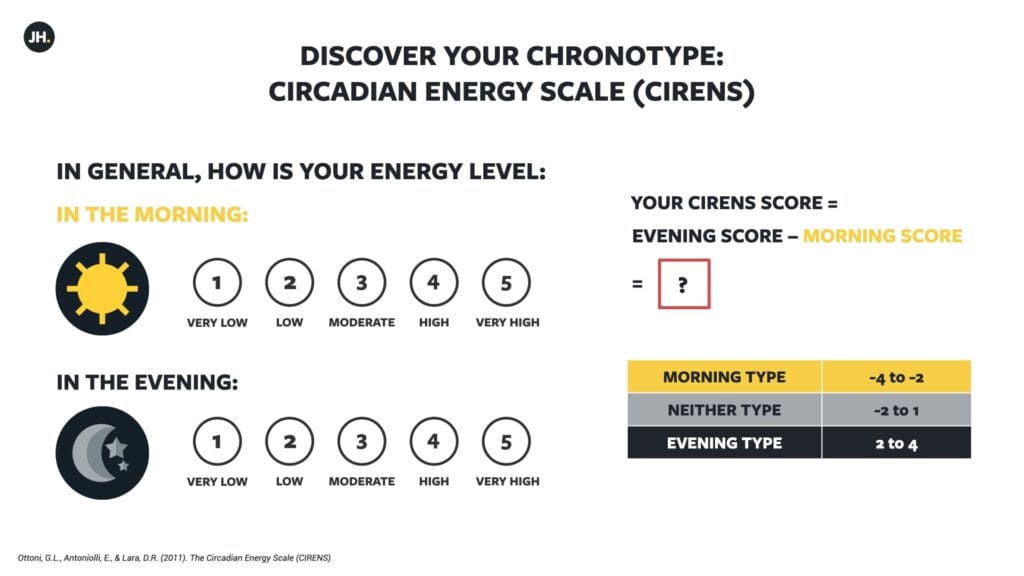On average, human performance can vary by around 20% during the average day, but when are we at our best?
While some researchers have found that performance improves through the day; others suggest that it decreases. Some investigators describe how performance gets better up to a midpoint, then drops off again. Introduce motivation, psychological characteristics, and physical state into these models, and you have a messy picture!
I’m very interested in variations in performance in the workplace, and it’s something that I’m investigating in my ongoing research in high-performance knowledge workers, but wouldn’t it be great if we could find a simple way to evaluate our own rhythm?
A Bias Toward ‘Morningness’ Or ‘Eveningness’
Our bias towards ‘morningness’ (feeling that we perform better in the morning), ‘eveningness’ (perfoming better later in the day), or getting the sense that we are somewhere in the middle, has been associated with our ‘chronotype’: the behavioural manifestations of the physical processes which are influenced and governed by our ‘circadian rhythms’: the (approximately) 24 hour cycle of physiological processes which can be measured in humans, as well as plants, animals, fungi and even some bacteria.
Some research suggests that around 20% of the population feel at their best in the morning. Around 20% feel better later in the day, into the evening, and around 60% of us fall somewhere in the middle2. You could characterise this variation in three phases:
- Peak: The best time for focus and productivity
- Valley: The best time for rest and reflection
- Rebound: The ideal opportunity for menial tasks and ‘switching work’

The order of these phases is likely influenced by our ‘personal rhythm’. For example, ‘early birds’ who feel at their best in the mornings, are likely to experience the day as a Peak, Valley, Rebound. ‘Night owls’ who generally prefer evenings, often experience this variation in reverse, starting the day with a rebound, still experiencing a valley in the middle, before reaching their peak performance period later into the day and into the evening. You can read more about this in my article about ‘Knowledge Work As An Endurance Activity’.
How To Assess Your Chronotype
You probably have a sense of your own rhythm, but there are a variety of tools to assess your chronotype. Sometimes, it can be helpful to ‘put a number on it’, and one of the quickest and most simple validated tools is called the ‘Circadian Energy Scale’ (3).
The scale includes two questions:
- In general, how is your energy level in the morning.
- In general, how is your energy level in the evening.
Answer each question on a scale from 1-5:
- Very low
- Low
- Moderate
- High
- Very High
You should end up with two numbers: one for your morning energy, the other for your evening energy. Subtract your morning score from your evening score. For example, my morning score is 4, and my evening score is 2. Therefore, I calculate 2 – 4 = -2.
When you have your answer, check it against the table, below, to find your preference.
Morning type: -4 to -2
Neither type: -1 to 1
Evening type: 2 to 4
My example suggests that I am a morning type, which feels about right for me.

In contrast to other scales, the short Circadian Energy Scale assesses chronotype without asking any questions about sleep time, sleep duration, or wake-time. However, the results are still highly correlated with the results of much longer surveys, such as the popular MEQ chronotype score.
I encourage you to try out the Circadian Energy Scale and see what number you come up with. Perhaps ask your friends and colleagues to try it, too. I also encourage you to repeat the assessment if you have the opportunity to take a vacation. Answer the questions at the beginning and end of the break and see if anything has changed. You may be surprised by the result when you are not ‘forced’ into a rhythm by your workplace.
References
- Hines, C. B. (2004) ‘Time-of-Day Effects on Human Performance’, Catholic Education: A Journal of Inquiry and Practice, 7(3), pp. 390–413.
- Adan, A. et al. (2012) ‘Circadian typology: A comprehensive review’, Chronobiology International, 29(9), pp. 1153–1175. doi: 10.3109/07420528.2012.719971.
- Ottoni, G.L., Antoniolli, E., & Lara, D.R. (2011). The Circadian Energy Scale (CIRENS)

